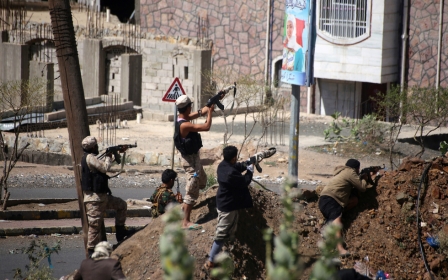How Yemen's war mutated into a free-for-all

TAIZ, Yemen - Yemen's war has mutated in little over a year from a battle between the Houthi movement and Saudi-backed forces loyal to President Abd Rabbuh Hadi, into one where former allies turn against each other as the original antagonists sit down for peace talks.
Events in Taiz since March highlight how much the war has changed.
"Popular resistance" forces broke through Houthi lines to lift an eight-month siege of the city in mid-March, then waited for Emirati troops from the Saudi-led coalition to arrive and hold the ground.
But for the rookies of the Saaleek brigade, that help never came. The UAE's forces were bogged down in neighbouring Lahj province, fighting the growing threat posed by al-Qaeda in the Arabian Peninsula.
Only days before militants from the group, also known as AQAP, had reportedly shot down an Emirati jet over Aden, killing two pilots, with a missile apparently supplied by their former Saudi coalition allies.
Nabil al-Adimi, a Saaleek commander, said that lack of support for his civilian militia in Taiz forced its later withdrawal.
"The fighters of the Popular Resistance are civilians and most of the Yemeni army in Taiz are loyal to the Houthis, so it is difficult to liberate the city ourselves," he told Middle East Eye.
"We needed support from coalition troops, armoured vehicles and tanks.
"Only some missiles, Kalashnikovs and ammunition got to the city, but the Emirates forces did not support us, so the Houthis imposed the siege again after one week.
"We learned that no one cares about Taiz, and we have to depend on ourselves to liberate our city. We are civilians and this will cost us so much, but it is the only solution, as we will not surrender to the Houthis."
According to officials in Aden, Emirati forces have switched focus from the Houthis to AQAP, and by extension the Islamic State group, following a series of attacks against coalition forces.
A Houthi-coalition ceasefire is due to begin on 10 April, with peace talks scheduled for 18 April in Riyadh.
It is a remarkable contrast to the events of last year.
Elements of AQAP fought alongside Popular Resistance militias and coalition forces as they battled the Houthis last year in the south of Yemen.
However, this shaky alliance soon fell apart, and AQAP turned on their allies after the liberation of Aden and surrounding areas.
Since then, a wave of attacks have shaken the coalition and Hadi loyalists.
In September, 45 UAE troops were killed in Marib, in what was described by the coalition as an "accidental explosion". Three months later, IS assassinated Aden's governor, Jaafar Saad, and launched attacks on Emirati and Yemeni army troops.
Then last month, the Emirati Mirage jet was apparently shot down in al-Boraiqa district of Aden.
The crash was described as a "technical fault" by the Saudi state news agency SPA.
However, a source in Aden's police office said AQAP brought the jet down with a missile supplied by the coalition when fighting with the Popular Resistance in Aden.
"We investigated, and we found that AQAP shot down the jet after it targeted their fighters in al-Mansoura district," the source told MEE.
Three other jets have been destroyed since the coalition began its campaign in March 2015 - one each from the Saudi Arabian air force, Morocco and Bahrain.
The police source said the Yemeni army, with the help of the Emirati forces, had started a campaign against the AQAP in Aden, recapturing al-Mansoura district from AQAP last week.
The director of Aden's police office, brigadier Shalal Shaei, told MEE: "We are implementing plans by the Emirates forces in Aden. These plans aim to make Aden and Lahj free from extremist groups that target both of the coalition forces and the Yemeni officials."
The consequence, however, is that the UAE has stopped fighting the Houthis, providing the resistance's fighters only with military plans, training and military vehicles.
Saudi-led air strikes, meanwhile, have begun to concentrate on AQAP in Aden, Lahj, Abyan and Hadramout.
Fadhl al-Rabei, a political analyst and the head of Madar Strategic Studies Centre based in Aden, said coalition forces could only advance towards Taiz city after they had uprooted AQAP and IS fighters in Aden and other southern provinces.
"If the coalition troops go towards Taiz, the AQAP fighters will attack in Aden and Lahj, which will aid the Houthis' return, so they have to stay there," Rabei said.
He stated that it was difficult as the coalition faced a daunting task - AQAP fighters are originally from the southern provinces, and are masters of their land.
Rabei said the situation means Yemen is now divided into three spheres of influence: the north under the Houthis; areas controlled by pro-Hadi forces and the coalition in the south; and districts dominated by AQAP including al-Mukala in Hadramout, Azzan in Shabwa, Zinjubar in Abyan, and al-Hawta in Lahj.
The UAE military and Saudi coalition did not respond to repeated requests from MEE for comment on the war in Yemen.
Middle East Eye propose une couverture et une analyse indépendantes et incomparables du Moyen-Orient, de l’Afrique du Nord et d’autres régions du monde. Pour en savoir plus sur la reprise de ce contenu et les frais qui s’appliquent, veuillez remplir ce formulaire [en anglais]. Pour en savoir plus sur MEE, cliquez ici [en anglais].





